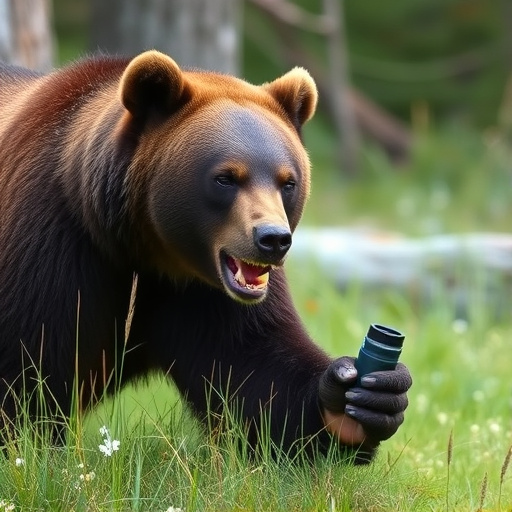Bear spray, a popular deterrent for Alaskan hikers, effectively scares bears due to its capsaicin content. Responsible disposal is crucial to prevent environmental harm from used cans. Alternative methods like noise makers and scent barriers offer less potent options with varying efficacy. To minimize the Environmental Effects of Bear Spray Decomposition, hikers should follow best practices: use spray correctly, maintain distance from bear habitats, practice responsible waste management, stay on trails, and respect bears as ecosystem contributors.
Alaska’s rugged landscapes are home to formidable bears, making proper preparation essential for outdoor enthusiasts. This guide explores the critical components of bear repellent hiking gear, with a focus on understanding bear spray and its environmental impact. We delve into the composition and efficacy of bear spray, examine alternative repellents, and provide best practices for safe and sustainable hiking in Alaska. Additionally, we discuss the environmental effects of bear spray decomposition, offering insights for responsible outdoor adventure.
- Understanding Bear Spray: Composition and Efficacy
- Environmental Impact of Bear Spray Decomposition
- Alternative Bear Repellents and Their Advantages
- Best Practices for Safe and Sustainable Hiking in Alaska
Understanding Bear Spray: Composition and Efficacy
Bear spray, a crucial component of Alaska hiking gear, is designed to deter and repel bears when encountered in the wild. It’s more than just a pungent liquid; it’s a carefully crafted solution typically composed of capsaicin, the same compound that gives chili peppers their heat. This active ingredient irritates a bear’s eyes, nose, and respiratory system, temporarily disorienting it and encouraging an immediate retreat.
The environmental effects of bear spray decomposition are minimal when used responsibly. When applied correctly to a bear, the spray forms a protective barrier around the hiker, breaking down rapidly upon exposure to air and leaving no harmful residue. This quick breakdown is essential for minimizing ecological impact, ensuring that the spray doesn’t persist in the environment and potentially affect non-target species or water sources.
Environmental Impact of Bear Spray Decomposition
Bear spray is a popular and effective deterrent for encountering bears while hiking in Alaska. However, it’s crucial to understand the environmental impact of its decomposition. The active ingredients in bear spray can persist for some time before breaking down naturally, but this process isn’t instantaneous. Left unattended, used bear spray cans can pose risks to water sources and wildlife due to leaching chemicals.
The Environmental Effects of Bear Spray Decomposition include the potential contamination of soil and waterways, which can have far-reaching consequences. It’s essential for hikers to dispose of used bear spray responsibly, adhering to local guidelines, and never leaving cans behind in sensitive areas. By making informed choices about their repellents and proper disposal, outdoor enthusiasts contribute to preserving Alaska’s ecological balance.
Alternative Bear Repellents and Their Advantages
In addition to traditional bear spray, hikers have several alternative bear repellent options that offer unique advantages. One such option is the use of noise makers, like whistles or bells attached to clothing or gear. While not as potent as spray, these devices can startle bears and provide a moment of escape for hikers. Additionally, certain scents like capsaicin, found in hot peppers, have been shown to deter bears due to their irritation-inducing properties. These non-spray repellents are appealing for those who prefer a quieter approach or want to minimize the environmental effects of bear spray decomposition.
Another alternative is using scent barriers, such as specialized clothing and gear treated with synthetic urines or other chemical repellents. These products mimic natural bear deterrents, making hikers less attractive to bears without causing harm. However, the effectiveness of these barriers can vary based on the specific product and the type of bear encountered. Ultimately, understanding the strengths and weaknesses of different bear repellents allows hikers to make informed decisions tailored to their needs and the environment they’ll be navigating.
Best Practices for Safe and Sustainable Hiking in Alaska
When hiking in Alaska, especially in areas known for bear activity, it’s crucial to prioritize safety and sustainability. Here are some best practices to ensure a positive experience while minimizing the environmental effects of bear spray decomposition. First, always carry and know how to use bear repellent spray effectively. It is not just a deterrent but a necessary tool for self-defense against aggressive bears. Keep your distance from bear habitats and avoid traveling in groups alone; bears are typically shy but may become curious or protective if they perceive a threat.
Proper waste disposal and minimizing scent trails are essential to reduce the impact on the environment. Always pack out what you pack in, ensuring no food remnants or garbage are left behind. As you hike, stay on designated trails to prevent encroaching on bear habitats and minimize your scent’s spread. Remember, bears play a vital role in Alaska’s ecosystem, and your responsible hiking practices can help preserve this delicate balance.
When hiking in Alaska, understanding the environmental impact of bear spray decomposition is crucial. While effective at deterring bears, the chemical breakdown can have long-lasting effects on the ecosystem. To ensure safe and sustainable hiking practices, consider alternative bear repellents and adhere to best practices, such as making noise to signal your presence and properly storing and disposing of food. By being prepared and mindful of our actions, we can enjoy Alaska’s beauty while minimizing the ecological footprint.
